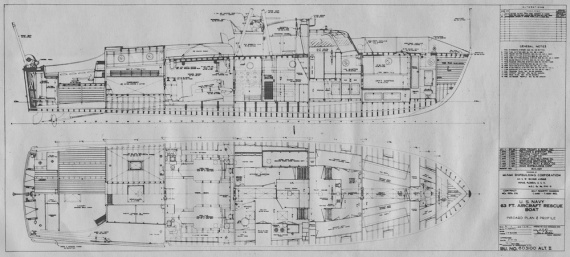HMAS Air Hope
| Class |
Air/Sea Search and Rescue Vessel |
|---|---|
| Type |
Air-Sea Rescue Launch |
| Pennant |
ASR908 |
| Builder |
South Coast Co, USA |
| Commissioned |
13 February 1945 |
| Decommissioned |
20 July 1946 |
| Fate |
Transferred to the Royal Australian Air Force |
| Dimensions & Displacement | |
| Displacement | 24 tons |
| Length | 63 feet (19.2 metres) |
| Beam | 15 feet (4.57 metres) |
| Draught | 3 feet 4 inches (1.01 metres) |
| Performance | |
| Speed | Up to 28 knots |
| Complement | |
| Crew | 7-8 including 2 RAAF telegraphists |
| Propulsion | |
| Machinery | Twin Hall-Scott petrol engines |
| Horsepower | 1200 bhp |
| Armament | |
| Guns | 2 x twin Lewis guns |
HMAS Air Hope was one of 21 air/sea rescue vessels originally built in the USA and Canada between 1943 and 1945, and transferred to the RAN under the Lend-Lease Agreement. These vessels were originally designed as anti-submarine craft but their high speed and manoeuvrability made them ideal as search and rescue vessels. In this role, their hulls were painted black and their upper decks and superstructure painted bright yellow. One vessel, HMAS Air Sprite, was built locally in 1960 to an almost identical design.
Air Hope was commissioned on 13 February 1945 in Sydney under the command of Lieutenant Ronald Dunn, RANVR, and officially listed as a tender to HMAS Madang. Her first few weeks of commission were spent at Garden Island in Sydney preparing for sea and conducting trials before proceeding northwards for Madang, New Guinea, on 23 April in company with her sister ships, HMA Ships Air Mercy and Air Speed.
Progress northwards was slow due to a combination of mechanical defects and, in north Queensland waters, poor weather. On 19 July, while en route to Milne Bay, Air Hope was instructed to return to Port Moresby where she would be based for ASR duties. She remained on standby for ASR duties until her return to Australia in mid-1946 but was not required for rescue operations in that time. Instead, she conducted a mine search off Port Moresby in November. In December, her coxswain was returned to Australia on compassionate leave and in January 1946 her two RAAF wireless operators were demobilised leaving her with a crew of just four. She decommissioned on 20 July 1946 and was transferred to the RAAF in 1949.



